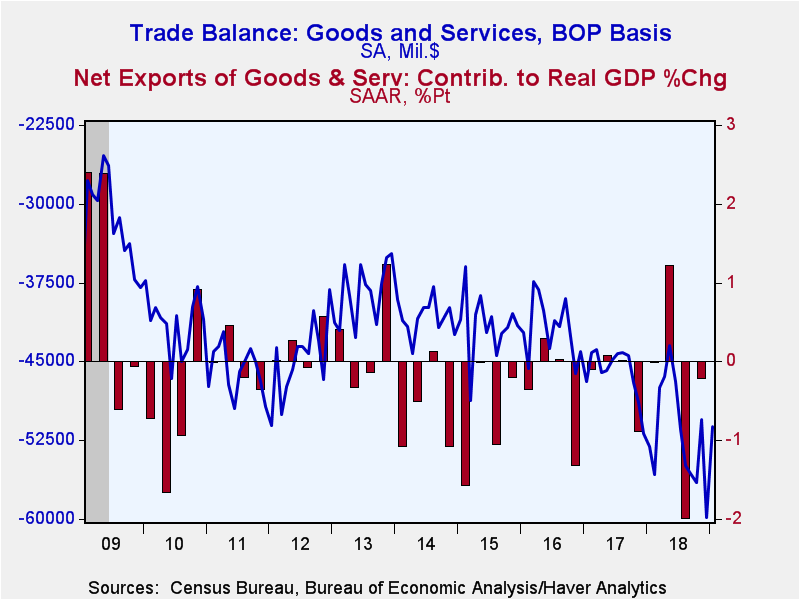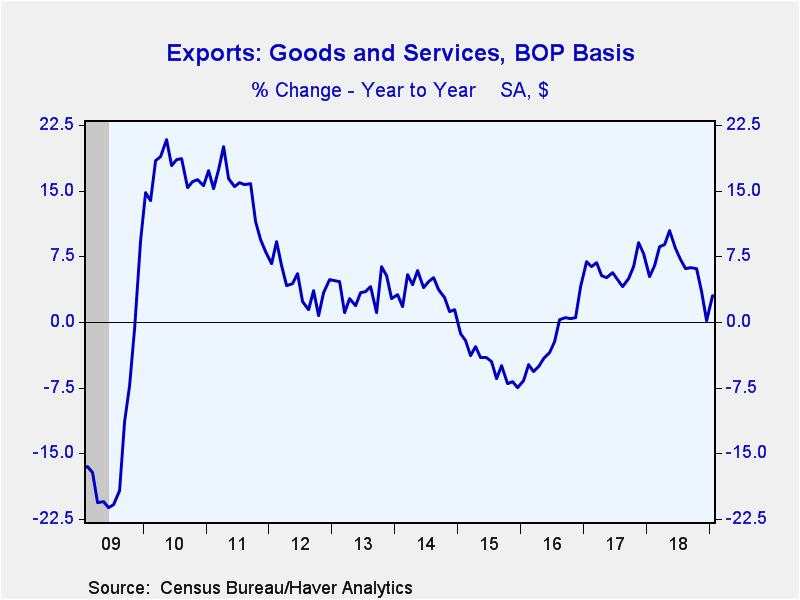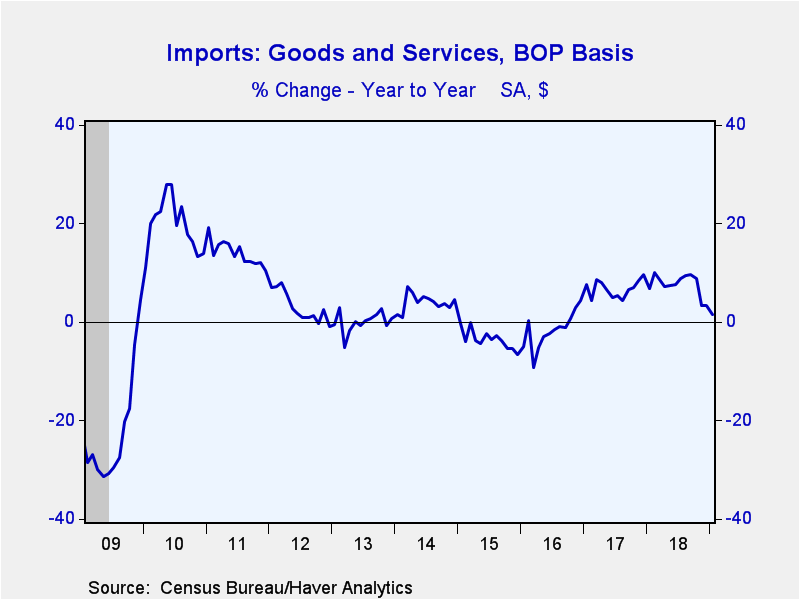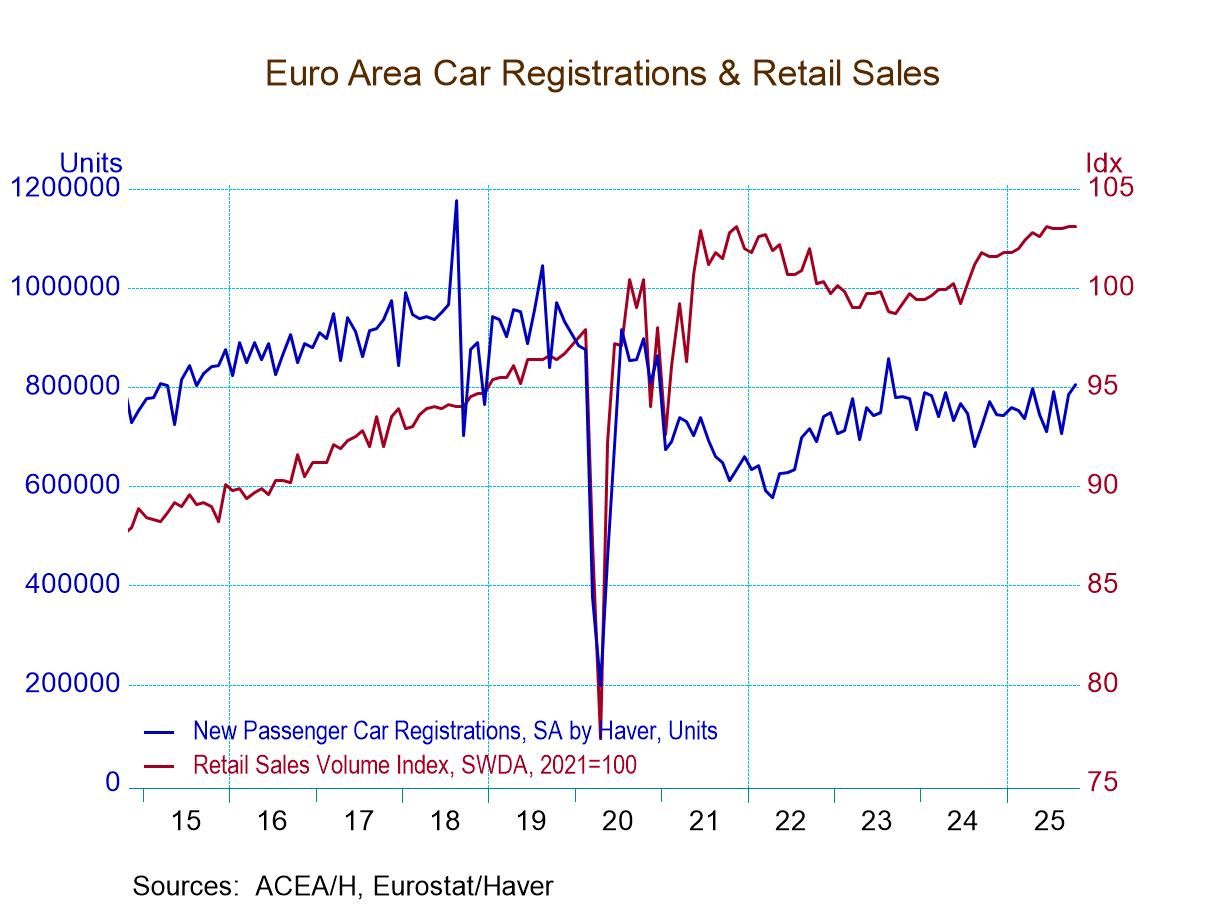 Global| Mar 27 2019
Global| Mar 27 2019U.S. Trade Deficit Narrows as Imports Fall
by:Tom Moeller
|in:Economy in Brief
Summary
The U.S. trade deficit in goods and services fell to $51.15 billion during January from $59.90 billion in December, revised from $59.77 billion. A deficit of $57.7 billion had been expected in the Action Economics Forecast Survey. [...]
The U.S. trade deficit in goods and services fell to $51.15 billion during January from $59.90 billion in December, revised from $59.77 billion. A deficit of $57.7 billion had been expected in the Action Economics Forecast Survey. Exports recovered 0.9% (3.0% y/y) following two months of decline, while imports fell 2.6% (+1.6% y/y) and reversed the December rise.
The deficit in goods trade narrowed to $73.29 billion from the record $81.53 billion in December. Exports of goods recovered 1.3% (3.3% y/y) led by a 13.1% surge (7.9% y/y) in foods, feeds and beverage exports, which followed declines in five of the prior six months. Autos exports rose 9.9% (-0.5% y/y) after declining for three straight months. Nonauto consumer goods grew 3.9% (-0.3% y/y) after a 0.7% rise. Capital goods exports fell 1.7% (+2.4% y/y) after a 3.5% drop and industrial supplies (which include oil) eased 0.7% (+6.1% y/y).
Imports of goods declined 3.0% (+1.1% y/y) in January. Industrial supplies & material imports fell 5.0% (-6.8% y/y) as oil prices declined. Nonpetroleum imports overall were off 2.7% (+3.5% y/y) after a 3.4% rise. Capital goods imports declined 4.9% (+2.3% y/y) and reversed the prior month's gain. Foods, feeds and beverages imports fell 2.5% (+3.7% y/y) after a 3.5% jump. Auto imports eased 0.5% (+4.1% y/y) following stability in December. Imports of nonauto consumer goods eased 0.6% (+3.7% y/y) after rising 4.4%.
The trade surplus in services improved slightly to $22.14 billion in January after deteriorating in five of the prior six months. Services exports rose 0.2% (2.5% y/y) as travel exports were little changed (1.3% y/y and charges for the use of intellectual property also were steady (-3.2% y/y). Services imports declined 0.7% (+4.0% y/y). Travel imports fell 1.2% (+7.2% y/y) while intellectual property product imports improved 0.3% (1.3% y/y).
The real (inflation-adjusted) goods trade balance narrowed sharply to $83.8 billion and reversed most of December's deterioration. Real exports rose 2.1% in January (4.9% y/y) and made up the prior month's decline. Real imports fell 2.0% (+2.8% y/y), the third decline in four months.
The trade deficit in goods with China narrowed sharply to a seasonally adjusted $33.22 billion. It was the narrowest deficit since June 2018. Exports to China fell 2.8% (-27.5% y/y) and imports dropped 12.3% (-11.2% y/y). The trade deficit with Japan eased to $5.35 billion as exports rose 12.4% y/y and imports increased 2.2% y/y. The trade deficit with the European Union narrowed sharply to $13.11 billion, its smallest since June. Exports rose 19.5% y/y and imports increased 8.1% y/y.
The international trade data as well as oil prices can be found in Haver's USECON database. Detailed figures on international trade are available in the USINT database. The expectations figures are from the Action Economics Forecast Survey, which is carried in AS1REPNA.
| Foreign Trade in Goods & Services (Current $) | Jan | Dec | Nov | Jan Y/Y | 2018 | 2017 | 2016 |
|---|---|---|---|---|---|---|---|
| U.S. Trade Deficit ($ bil.) | 51.15 | 59.90 | 50.53 | 53.09 (1/18) |
622.11 | 552.28 | 502.00 |
| Exports of Goods & Services (% Chg) | 0.9 | -1.9 | -0.7 | 3.0 | 6.4 | 6.1 | -2.2 |
| Imports of Goods & Services (% Chg) | -2.6 | 2.1 | -2.8 | 1.6 | 7.6 | 6.8 | -1.7 |
| Petroleum (% Chg) | -6.2 | -8.7 | -14.4 | -22.9 | 21.0 | 27.2 | -19.5 |
| Nonpetroleum Goods (% Chg) | -2.7 | 3.4 | -2.4 | 3.5 | 7.5 | 5.6 | -1.2 |
Tom Moeller
AuthorMore in Author Profile »Prior to joining Haver Analytics in 2000, Mr. Moeller worked as the Economist at Chancellor Capital Management from 1985 to 1999. There, he developed comprehensive economic forecasts and interpreted economic data for equity and fixed income portfolio managers. Also at Chancellor, Mr. Moeller worked as an equity analyst and was responsible for researching and rating companies in the economically sensitive automobile and housing industries for investment in Chancellor’s equity portfolio. Prior to joining Chancellor, Mr. Moeller was an Economist at Citibank from 1979 to 1984. He also analyzed pricing behavior in the metals industry for the Council on Wage and Price Stability in Washington, D.C. In 1999, Mr. Moeller received the award for most accurate forecast from the Forecasters' Club of New York. From 1990 to 1992 he was President of the New York Association for Business Economists. Mr. Moeller earned an M.B.A. in Finance from Fordham University, where he graduated in 1987. He holds a Bachelor of Arts in Economics from George Washington University.










